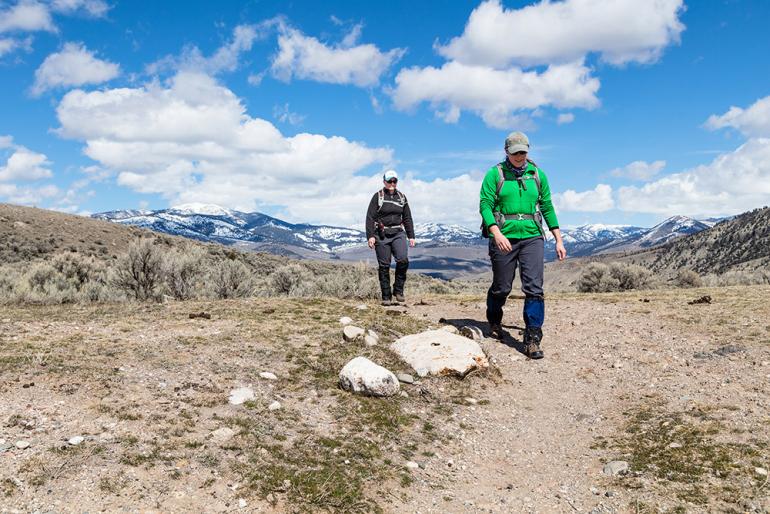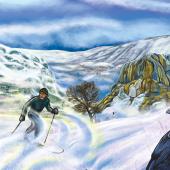Yellowstone Walkabout
An early-summer walkabout—that’s what my wife Lucy and I had in mind that bright Montana morning. We left Gardiner, the little town of 850 people on the Park’s northern border, and drove two-and-a-half miles north on the Old Yellowstone Road. This washboarded road runs parallel to the old railroad bed that brought early visitors to view the wonders of Yellowstone. After parking the truck, we began our walk heading west along the foothills of Sepulcher Mountain and Electric Peak.
The sagebrush-strewn ground was flat as we headed for an obvious creek lined with cottonwood trees. Stephens Creek flowed quickly this time of year, bringing the snowmelt down from the highlands. The cottonwoods showed their color and the grassy foothills seemed to glow a thousand shades of Ireland green. Fast-moving high clouds caught the mountain peaks, obscuring them from our view. Occasionally, the clouds opened and shafts of warm sunlight cascaded down, creating a magical sight as the sunlit spots quickly raced across the green hills.
Approaching the trees, we saw National Park Service signs warning we were near a temporarily closed Bear Management Area. Yellowstone’s bear management biologists post signs keeping people away from a site that has daily bear activity, usually near a fresh carcass. We obeyed the rules, turned and made our way southwest, up the creek, toward stands of aspen and higher ground. We followed worn dirt paths made by countless years of elk, pronghorn, and deer migrations. The rolling hummocks of grass obscured our view for the next few hundred yards. To alert bears that were out and about in the woods, we made a bit of noise. Cresting the hill, a flash of brown movement caught my attention. Down below us in a stand of aspen were two cow elk. One was resting while the other grazed on the lush tall grasses. Backing slowly away, we stayed quiet, as to not disturb and cause them to leave their afternoon shade.
Farther up in the cottonwoods, large shed elk antlers littered the landscape, an obvious sign that this was the wintering ground of the old bulls. Looking at six- and seven-point antlers, we could imagine the story about the lives and seasons of these magnificent creatures. Antlers of that size tell a tale of a long life: surviving countless hunting seasons just outside the northern Park boundary; harsh winters filled with long months of Montana snow; and spring and fall season chases by the neighboring Swan Lake (now defunct) and Chief Joseph wolf packs.
Lucy and I meandered through the boggy areas and grassy knolls of cottonwoods, stopping to photograph small clusters of mushrooms. Lucy suddenly whispered “bear!” which made my pulse quicken. Looking up the slope, I saw a large black bear sitting on its rump among the aspen trunks. The bear was unaware of our exact location but seemed very interested to find out. This ol’ bruin was enjoying an afternoon nap, listening to the wind in the aspen leaves, swatting an occasional mosquito, when suddenly it awoke to the sound of humans. The bear raised its wide nostrils and sniffed for any signs of us “two-legged kind.” Lucy let out a “Hey, bear!” and the bear looked in our direction. We were both equipped with pepper spray and we waited for the bear to help us decide our next move. The bear stood on all fours. It slowly turned and walked away into the thick Douglas firs that skirted the aspens. Neither of us was too scared, just fully aware of our surroundings and ready to react accordingly. We moved farther up the drainage to a higher ridge and again saw the bear sitting quietly behind a tree on the uphill side, trying hard to blend in with its surroundings. It seemed to be alone. Due to its size and lack of cubs, we thought it to be a male black bear. Later in the hike we saw fresh bear scat and torn-apart rotten logs, so we continued to make noise as we walked on.
The white phlox, rose-purple-colored shooting stars, lupine, and the hairy purple pasqueflower were blooming at our feet. We made it to a vantage point and saw our tiny town of Gardiner far below, with a pocketful of lakes separating us from civilization. As we made our descent through this riparian zone, two red-tailed hawks soared overhead, calling with their notable down-slurred, raspy scream: cheeeeeeew. One had its talons visible, dangling below as it rode the high afternoon winds. We spooked two common snipes in the tall rushes of a drying kettle pond. Cresting another hill, a picked-clean bull elk carcass lay in the grass. It was stripped of all that was edible, and we were unable to tell how it died. The antler tines were driven deep into the ground and I imagined a grizzly had rested its paw on the back of the neck, pushing the antlers into the dark, rich soil as it ate its first meal after months of long winter slumber.
As we approached a small lake, yellow-headed blackbirds mixed with red-winged blackbirds among the reeds. Meandering along the water’s shore, a V-shaped break in the water alerted us to a beaver swimming away. It turned in our direction only for a moment before it dove, showing us its wide, distinctive tail.
Walking back down into sagebrush hills, we caught glimpses of elk bedded in the dark green grass. Around a bend, we startled a cow elk that quickly stood and ran. We continued walking and suddenly, right there before us was the beautiful, licked-clean, white-spotted, sleek brown coat of a new elk calf! The little calf was nestled into the afternoon shade of sagebrush. Its mother, now high above on a ridge, was hoping to draw our attention away from her hidden baby. She must have been nervous… as was her little calf. As we quietly skirted around the little one, I was able to snap two pictures of its lowered floppy ears, big brown eyes that were full of life, and gangly long legs. It was a beauty. We were sorry for running off the mother, but were happy that the calf would survive this day’s encounter with one of its many known predators.
As Lucy and I took our last steps through the arid soil of the Sepulcher foothills, we were witness to another bit of spring in Yellowstone Country. A female pronghorn antelope waddled over a hill, bulging at her mid-section, obviously ripe with young. She was no doubt looking for a likely place to bed down and give birth to twins, the usual case with pronghorn. She looked quite ready to shed her burden. We immediately walked on, arching far away from her.
As we came back into Gardiner, we walked to the Yellowstone River. Snowmelt swelled and saturated the root systems of cottonwoods lining the river’s edge. Now, overflowing, fast-moving, cold, dark, and muddy waters frothed and looked very deep in the afternoon light. Large tree trunks tossed in the fast current. Downstream they would be hung up in a log-jam far away from where they began their life so many years before.
We could not believe the luck we had this day. Away for only a few hours, we were witness to many of the amazing and dynamic wonders that make an early-summer day in Yellowstone Country so special.
Best in the West
From rodeos to races, symphonies to Shakespeare, there’s more going on in West Yellowstone this summer than you’d think. Here are some highlights:
Wild West Yellowstone Rodeo
June 16-17, 23-24, 30-July 1
Bareback riding, team roping, and bull riding are among the many events scheduled for this year’s rodeo, which will take place at the arena at the intersection of Yellowstone Avenue and Faithful Street. Performances start at 8 pm, and tickets are $10 for adults; $5 for children under 12. Visit yellowstonerodeo.com or call 406-580-6913 for more info.
Janet Clarkson Memorial Triathlon
June 17
This annual event, held in honor of an avid triathlete, consists of a .64-mile swim in the Madison Arm of Hebgen Lake, 7.3-mile bike ride and 5.2 mile run on forest service roads. The event starts and finishes at the Madison Arm Resort and benefits the West Yellowstone High School’s Scholarship Fund and the American Cancer Society. The race begins at 1 pm, and a dinner and dance follow. For more information on this popular and charitable event, contact Jack Clarkson at 406-646-9328 or visit janetstriathlon.com.
Shakespeare in the Park: Love’s Labor Lost
July 24
Montana State’s traveling troupe performs the Bard’s comedy on the west side of the historic Union Pacific building. Fill your evening with a Spaniard, princess, fool, king, and, of course, a wench—all at no cost (though donations are encouraged). Bring your own chairs, blankets and food. The show begins at 6 pm; visit www2.montana.edu/shakespeare for more info.
Music in the Mountains: Bel Cantos
August 11
This event, part of the Bozeman Symphony’s Far Afield summer program, features nine women from the Symphony Choir and accompanist Ken Christiansen. The group’s versatile repertoire comprises everything from Baroque to ragtime, and the event is free to the public. The Grizzly and Wolf Discovery Center hosts the singers; contact the center at 406-646-7001 to learn more.
Pineneedle Stampede Foot Race
September 2
Why spend your summer racing on roads? This event offers 10k and 6k races on the pavement-and traffic-free paths of the renowned Rendezvous Trail System in the Gallatin National Forest. There is also a kids’ race, and proceeds benefit local nonprofit groups. Contact Kelli at the Freeheel and Wheel at 406-646-7744.
-Mike St. Thomas









